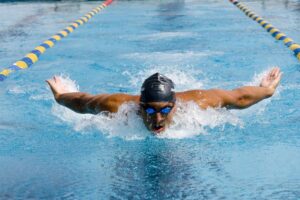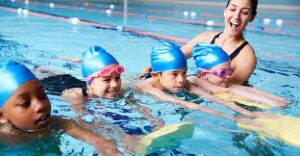Back to: Physical Health Education SS2
Welcome to today’s class!!
We are thrilled to have you in our class!!
In today’s Physical and Health Education class, we will be learning about Swimming II
Swimming II

Swimming is a great workout because you need to move your whole body against the resistance of the water.
Swimming is also a healthy activity that you can continue for a lifetime.
Competitive swimming continued to grow in popularity during the 1800s and was included in the first modern Olympic Games in Athens in 1896. In 1904, the Olympics in St. Louis included the 50-, 100-, 220-, 440-, 880-yard and one-mile freestyle, the 100-yard backstroke and 440-yard breaststroke, and a 4 x 50-yard freestyle relay.

By the 20th century, swimming had become mainstream. Indoor pools were beginning to appear, most towns with populations over 20,000 had public outdoor pools, and swimming clubs became increasingly popular for recreation. Women participated for the first time in swimming in the Olympic Games in Stockholm in 1912, and Johnny Weissmuller became the first person to swim 100 meters in less than one minute.
Swimming is a good all-round activity because it:
- keeps your heart rate up but takes some of the impact stress off your body
- builds endurance, muscle strength and cardiovascular fitness
- helps you maintain a healthy weight, healthy heart and lungs
- tones muscles and builds strength
- provides an all-over body workout, as nearly all of your muscles are used during swimming.
- being a relaxing and peaceful form of exercise
- providing good low-impact therapy for some injuries and conditions
- providing a pleasant way to cool down on a hot day.
Equipments Used in Swimming
- Kickboards
Kickboards are devices made of foam or other materials that float, and they come in a variety of shapes and sizes. The main purpose is for you to hold on and stay afloat while your legs do all the work. It’s good exercise for coordinating your kicking, and it gives your arms a rest.
- Fins
Fins fit on your feet and add propulsion to your kicks (think of a duck’s webfoot). They are great training for your legs and will help you swim faster. They come in long fins for beginners who want to work on their stroke and build up leg strength and ankle flexibility and short fins to help you go faster without overworking your legs. Fins should fit snugly but not so tight that they cut into your foot or cut off circulation.
- Hand Paddles
Hand paddles attach to your hands and add propulsion to your arm stroke because they move more water. They can be a lot of work for the arms and shoulders because of the resistance in the water, and for this reason, they are used in water aerobic classes to mimic the resistance exercises that you do on land with dumbbells. Hand paddles make a water workout difficult, and so you should warm up in the water without them first, and then build up slowly like you would with any resistance exercise workout so that you don’t overwork your arms and shoulder joints.
- Gloves
Gloves, like hand paddles, also add resistance for your arms, although they are smaller than paddles and so the resistance is lighter. These might be a better choice than paddles if you’re just starting out with resistance exercises in the water.
- Water Dumbbells
Some manufacturers produce dumbbells made of foam for use in the water. They add resistance like paddles or gloves, but you can release them quickly after a set and then grab them again when you’re ready. Water creates lots of resistance, and so water dumbbells will make you stronger if you use them consistently. They’re fun!
In summary, Swimming is a healthy activity that you can continue for a lifetime; it is also a low-impact activity that has many physical and mental health benefits.
Evaluation
Explain the origin of Competitive Swimming.
Reading Assignment
Who became the first person to swim 100 meters in less than one minute?
Weekend Assignment
List and explain five important equipment necessary for swimming.
We hope you enjoyed today’s class. In our next class, we will be learning about Life Saving.
Let us know your thoughts and questions in the comment section, and we will attend to them as fast as we can.
